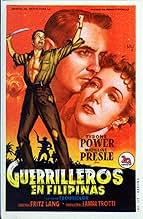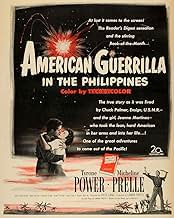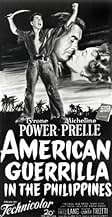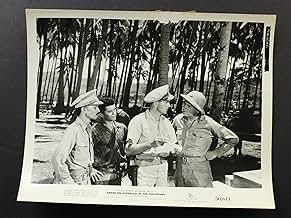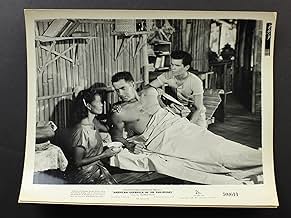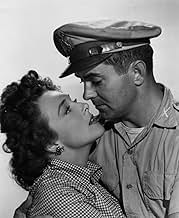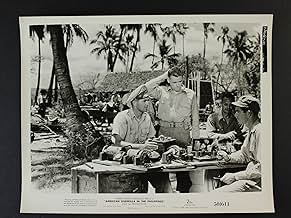IMDb RATING
5.9/10
1.4K
YOUR RATING
American soldiers stranded in the Philippines after the Japanese invasion form guerrilla bands to fight back.American soldiers stranded in the Philippines after the Japanese invasion form guerrilla bands to fight back.American soldiers stranded in the Philippines after the Japanese invasion form guerrilla bands to fight back.
Micheline Presle
- Jeanne Martinez
- (as Micheline Prelle)
Robert Patten
- Lovejoy
- (as Bob Patten)
Miguel Anzures
- Native Traitor
- (uncredited)
Sabu Camacho
- Bo
- (uncredited)
Erlinda Cortes
- Partisan
- (uncredited)
Cris de Vera
- Japanese Officer
- (uncredited)
Rosa Del Rosario
- Partisan
- (uncredited)
Maria del Val
- Señora Martinez - the Aunt
- (uncredited)
Vic Diaz
- Japanese General
- (uncredited)
Arling Gonzales
- Radio Operator
- (uncredited)
Fred Gonzales
- Radio Operator
- (uncredited)
Eddie Infante
- Col. Dimalanta
- (uncredited)
- Director
- Writers
- All cast & crew
- Production, box office & more at IMDbPro
Featured reviews
Not a bad movie, really. Colorful, exotic locations, educational, some interesting combat scenes. But coming from the director of "Metropolis" and "M"?
It reminds me of an anecdote told by the psychologist who wrote "The Three Christs of Ypsilanti." That's a psychiatric hospital in Michigan. Three patients claimed to be Jesus Christ. The psychologist was watching a film with the one named Louie. Adlai Stevenson, then Governor of Illinois, appeared on the screen. "That's me," cried Louie, "I'm Adlai Stevenson." The psychologist replied, "I thought you were Jesus Christ." "I am," said Louie, "I'm Jesus Christ too -- but I've got to make a living."
Fritz Lang must have had some similar motive for making this rather routine war film. It has every cliché in the book. The romance thrown into the middle of the muddle. The cavalry riding to the rescue at the last possible moment. The acting of the principals is at par, but some of the bits are played by people who seem to have had no training in inducing a suspension of audience disbelief.
The best scene in the film has Tom Ewell (in an uncommonly dramatic part) trying to hide from the Japanese under a rotting log. His bare feet are on an ant hill and soon his skin is crawling with stinging ants while he bites his tongue and prays.
The best performance is given by the Japanese officer. He's great. Sinewy, dapper, ruthless, ironic. Speaking to Michelline Presle, who has been aiding the guerrillas -- "You rike Americans with WHITE FACES, like boiled pork." Marvelous line. (That bleached skin, like blue eyes, is an evolutionary anomaly confined to northwestern Europe.) The guy is fascinating to watch physically, in the way that Jack Palance is.
Minor error. Ty Power and Tom Ewell are reporting on the position and movements of two Japanese destroyers (actually, they look like Geary-class American ships). Power gives the info on the ships to Ewell next to him, who relays it by phone to a radio operator who encodes and transmits it. But the operator isn't sending information on the location of the ships. He keeps sending the word "news" over and over, interspersed with a couple of letter "b"s.
It is not, as I say, a bad movie. It's just done rather by the numbers. A far better job dealing with our defeat in the Phillipines was done by John Ford in "They Were Expendable." This film is worth watching as a description of the very real guerrilla movement that developed in the Islands after that initial defeat.
It reminds me of an anecdote told by the psychologist who wrote "The Three Christs of Ypsilanti." That's a psychiatric hospital in Michigan. Three patients claimed to be Jesus Christ. The psychologist was watching a film with the one named Louie. Adlai Stevenson, then Governor of Illinois, appeared on the screen. "That's me," cried Louie, "I'm Adlai Stevenson." The psychologist replied, "I thought you were Jesus Christ." "I am," said Louie, "I'm Jesus Christ too -- but I've got to make a living."
Fritz Lang must have had some similar motive for making this rather routine war film. It has every cliché in the book. The romance thrown into the middle of the muddle. The cavalry riding to the rescue at the last possible moment. The acting of the principals is at par, but some of the bits are played by people who seem to have had no training in inducing a suspension of audience disbelief.
The best scene in the film has Tom Ewell (in an uncommonly dramatic part) trying to hide from the Japanese under a rotting log. His bare feet are on an ant hill and soon his skin is crawling with stinging ants while he bites his tongue and prays.
The best performance is given by the Japanese officer. He's great. Sinewy, dapper, ruthless, ironic. Speaking to Michelline Presle, who has been aiding the guerrillas -- "You rike Americans with WHITE FACES, like boiled pork." Marvelous line. (That bleached skin, like blue eyes, is an evolutionary anomaly confined to northwestern Europe.) The guy is fascinating to watch physically, in the way that Jack Palance is.
Minor error. Ty Power and Tom Ewell are reporting on the position and movements of two Japanese destroyers (actually, they look like Geary-class American ships). Power gives the info on the ships to Ewell next to him, who relays it by phone to a radio operator who encodes and transmits it. But the operator isn't sending information on the location of the ships. He keeps sending the word "news" over and over, interspersed with a couple of letter "b"s.
It is not, as I say, a bad movie. It's just done rather by the numbers. A far better job dealing with our defeat in the Phillipines was done by John Ford in "They Were Expendable." This film is worth watching as a description of the very real guerrilla movement that developed in the Islands after that initial defeat.
Had BACK TO BATAAN and BACK TO BATAAN not been made, then I assume that American GUERILLA IN THE PHILIPPINES would probably be a better remembered film. That's because it's an excellent movie in just about every way, but the earlier John Wayne and Robert Taylor films about the Philippines during WWII were very outstanding films and tend to overshadow this Tyrone Power flick.
While the plot is not identical to these other two films, there are many similarities. All three document the heroic efforts of the Philippino partisans as well as that of Americans stuck in this land during the war. About the only noticeable difference was that the Power film was in color and I really think for this subject matter, black and white actually worked better--looking more like what you'd expect a WWII film to look like. Plus, the other two films are just a little more exciting and involving--but this isn't to say this Power film is bad--it just isn't quite as involving.
Still, among the many, many WWII films, this one is a bit better than average and well worth a peek. And, yes, I also noticed the line that said a Navy Ensign is equivalent to an Army Major! I'm surprised that Power, with his WWII experience, would have said such a stupid line. An ensign is most closely equivalent to an Army Lieutennant--a much lower rank.
While the plot is not identical to these other two films, there are many similarities. All three document the heroic efforts of the Philippino partisans as well as that of Americans stuck in this land during the war. About the only noticeable difference was that the Power film was in color and I really think for this subject matter, black and white actually worked better--looking more like what you'd expect a WWII film to look like. Plus, the other two films are just a little more exciting and involving--but this isn't to say this Power film is bad--it just isn't quite as involving.
Still, among the many, many WWII films, this one is a bit better than average and well worth a peek. And, yes, I also noticed the line that said a Navy Ensign is equivalent to an Army Major! I'm surprised that Power, with his WWII experience, would have said such a stupid line. An ensign is most closely equivalent to an Army Lieutennant--a much lower rank.
This movie had a rush release just weeks before American soldiers get serious in Korea. A very good feel from this war drama about American fighters stranded in the Philippine Islands waiting for Gen. Douglas MacArthur's return. Guerrilla warfare helps sustain against the invading Japanese in 1942. Some very nice scenery and interesting war action. Top direction from Fritz Lang and potent acting from Tyrone Power and Tom Ewell.
This is a seldom referenced and very overlooked old movie, but Fritz Lang still shows what an amazing filmmaker he is here. The script is good (not great) but the direction and some surprisingly good acting turn this one into a real winner. Definitely worth watching.
The great Tyrone Power does it again! Not only does he wow the audience with his fabulous looks, he also makes you feel like you're really there, with his great acting ability. It is natural, not put on. The real chemistry with Michelle Perelle is very evident. (It's easy to see why Ty had thousands swarm to see him where ever he went.) You not only get a history lesson about the war in the Philippines, you also get to see it through the eyes of those who risked their lives and suffered through it! This includes Ty Power who sacrificed big bucks in offered movie contracts to go fight for our freedom instead. What a great American! It has dynamic movement, not a dull moment in it anywhere. The scenery is great, too! I must say I like having Tyrone Power doing the areas of narration, also. A real must to see with the whole family.
Did you know
- TriviaThis movie was filmed just prior to the outbreak of the Korean War in June of 1950, and used American warships to portray Japanese ships. One such ship, the U.S.S. Orleck (DD 886), exists to this day after serving in the Korean War, the Vietnam War and being sold for a while to the Turkish Navy, and is permanently docked in Lake Charles, LA, where it serves as a museum.
- GoofsWhen setting the sail early in the movie, Power's character refers to a halyard as a sheet. No real sailor would make such an error.
- ConnectionsEdited into La guerre, la musique, Hollywood et nous... (1976)
- How long is American Guerrilla in the Philippines?Powered by Alexa
Details
- Release date
- Country of origin
- Languages
- Also known as
- American Guerrilla in the Philippines
- Filming locations
- Production company
- See more company credits at IMDbPro
- Runtime
- 1h 45m(105 min)
- Aspect ratio
- 1.37 : 1
Contribute to this page
Suggest an edit or add missing content

